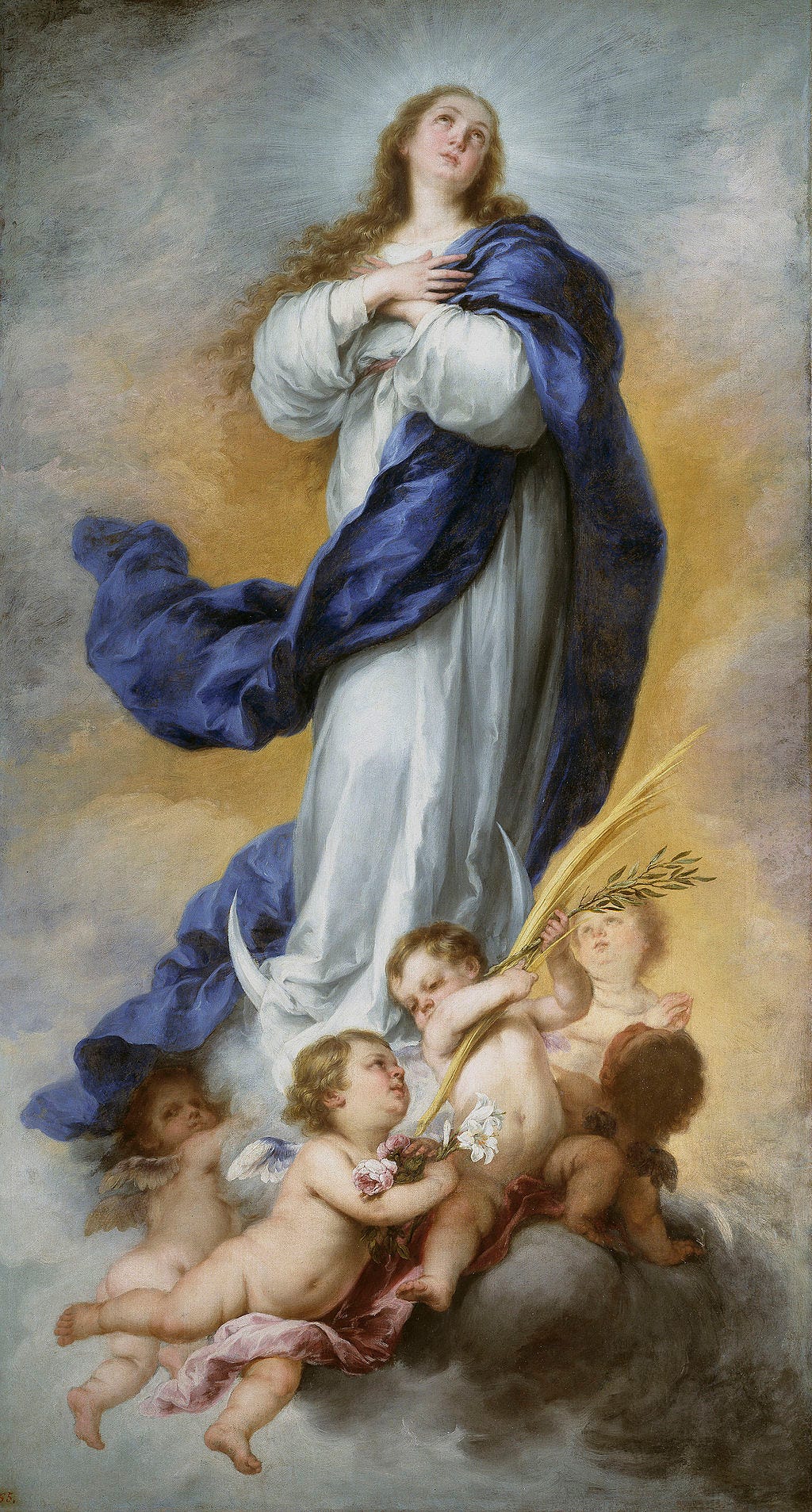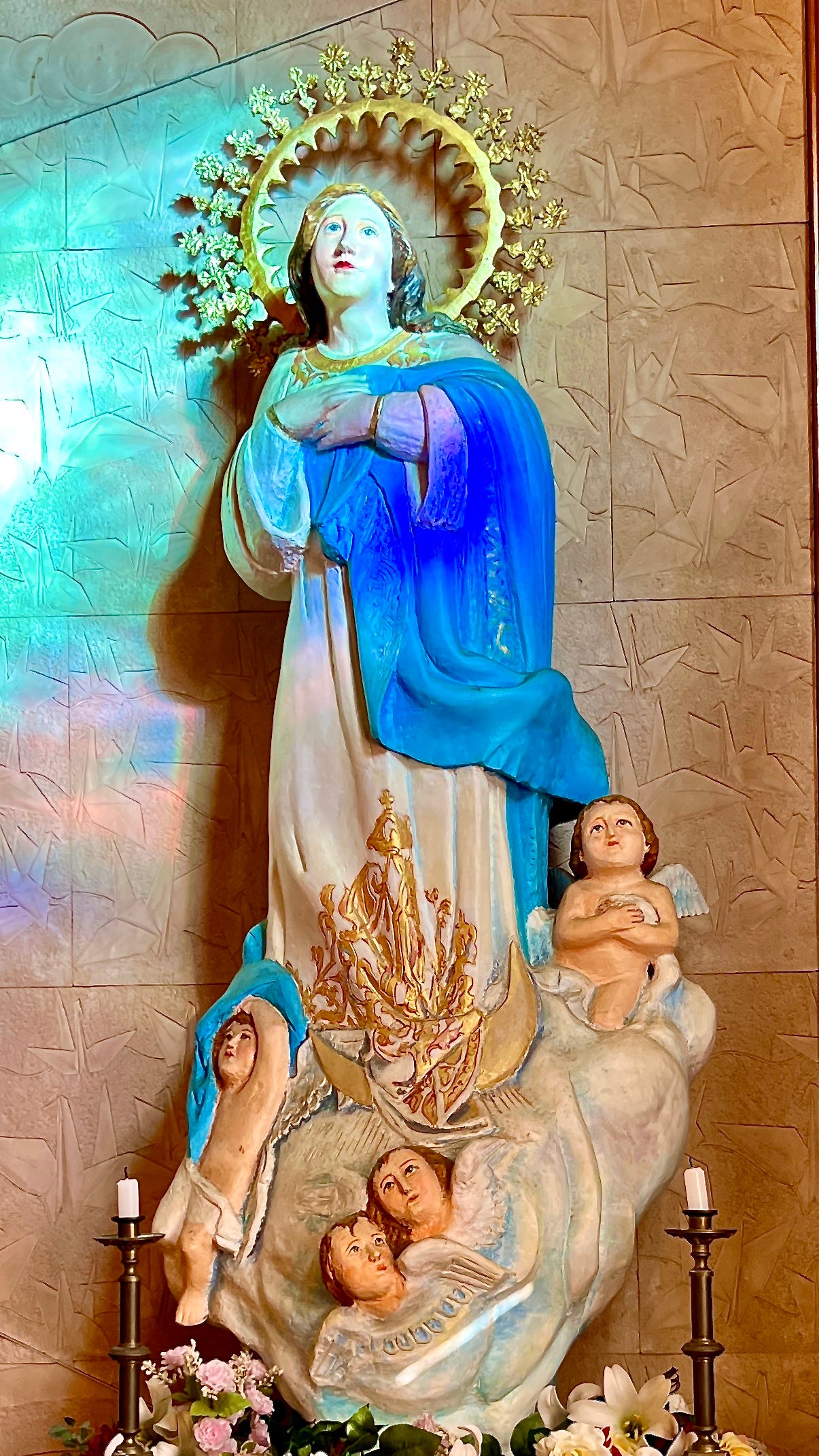Hibaku no Maria (Atom-Bombed Mary)
The dramatic history of two images of Our Lady in the Cathedral of the Immaculate Conception in Nagasaki
This article is about two photos (out of over 1,000) that I took while on a pilgrimage to Japan in early October. I took these particular photos at the Immaculate Conception Cathedral in the Urakami district of Nagasaki.
The current cathedral was built after the previously much larger cathedral was destroyed after the plutonium bomb was dropped on August 9, 1945. The bomb and the resulting fire killed most of the Catholics living in what had been for centuries the most densely Catholic part of Japan. Today I came across an article by one cynic who commented that the United States succeeded in doing in nine seconds what various Japanese governments tried but had not been able to do for centuries, in how it just about wiped out the Catholic faith in Japan.
On the dreadful August day, Immaculate Conception Cathedral alone had 12,000 members. 8,500 of them eventually died directly as a result of the blast, and many more suffered greatly for the rest of their lives from the physical and psychological effects of the horror that rained down on them from the sky, and out of these many died premature deaths.
The Urakami district had been the center for many hidden Catholics who went underground for 250 years after the Faith was outlawed, and they held onto the faith as best they could without clergy, even though they were forced every year to deny their faith during the "fumi-e" interrogations. Fumi-e interrogations were performed beginning in 1629, when government officials required every resident to tread upon an icon of the Virgin Mary or Jesus, as a trial to uncover Christians and sympathizers.
Those who were reluctant or refused to trample the image were arrested for being Christians. If they refused to deny their faith, they would be tortured. If they still refused, they would be killed. Some were executed at Nagasaki's Mount Unzen, where the Christians were boiled in the hot springs. Incidentally, the Unzen Springs were the setting for scenes in the book and the movie The Silence. (Some day I'll have to get around to writing about how much that book and that movie missed the point. )
The Catholics at Urikami selected the location for their planned cathedral because it was the location for the yearly fumi-e interrogations. They did it in shamed memory of the long years of tests of their faith on that spot, tests they must have failed or they wouldn't have survived. The work and expense of building the cathedral was undertaken in what must have been in large part a penance for the repeated yearly public apostasies most of them and their ancestors had committed.
Now about the statue of Mary. A two-meter, carved and painted wooden statue of Mary came to Urakami Cathedral in the 1930s from Italy. The image is said to have been based on a painting of the Immaculate Conception by Bartoleme Esteban Murillo (1618-1682).
A little Googling shows that Murillo actually painted and used other media to create a large number of images of Mary as the Immaculate Conception, five hang just in the Prado Museum alone. None of them look much like the modern statue that is supposed to be a recreation of the original at the cathedral.
Here’s the one I was able to find that has the closest resemblance
.
Many Nakasaki Christians grew to have great affection for the statue.
Then the statue was destroyed along with the cathedral and buried in the rubble.
The following information about the finding of the head of the statue is from a letter written by Father Noguchi, the Trappist monk who had been a soldier in the Japanese army and who found the atom-bombed Mary in a miraculous way. In 1975, the year of the thirtieth anniversary of the Bombing of Nagasaki, the head of the Mary statue was returned to the cathedral.
Dear Father Kawazoe, . . .
I have been debating, for some considerable time, whether or not I should inform you about the fact details of my discovery. When Bishop Matsunaga visited our monastery, I consulted him with my thoughts. The bishop recommended that I should write to you . . ..
I grew up in Urakami, Ishigami town (Yamanaka) and joined the Hokkaido Trappist Monastery in the fourth year of the Showa era (1929) and was ordained priest in the fourteenth year (1939). I must have been twelve or thirteen years of age when the statue of Virgin Mary arrived from Italy and was placed near the ceiling over the altar of the Urakami Cathedral. Her celestial beauty left a deep impression to my boyhood. I was then irresistibly attracted by the Madonna.
When I was to join the monastery in Hokkaido, I knelt down in front of the altar and prayed to bid my farewell ... "Dear Our Lady, I am going far north to the Trappist Monastery in Hokkaido, so this may be the last prayer I offer to you in this cathedral. But wherever I will be, may your protection and guidance be with me as ever." This memory never leaves me after all these years.
In April of the eighteenth year of the Showa era (1943), I was called to arms and returned home in Nagasaki. I enlisted in the Kurume Regiment and was once discharged in January of the twentieth year of the Showa era (1945). Until when I found myself once again in the Omura Regiment in April, I helped Father Nishida and Father Tamaya at Urakami Church. The altar had been beautifully rebuilt by the time and the statue of Virgin Mary was housed at the center of the altar.
The war was over on the fifteenth day of August. I was sent home after being discharged in October. Before going back to Hokkaido, I wished to find a keepsake of the cathedral to bring with me. So I went to the ruins of the church and yet I found nothing but a heap of rubble. I searched about the destroyed altar and confessionals of Father Nishida and Father Tamaya for over one hour in vain. I tumbled onto a stone and prayed to Virgin Mary just like when I departed for the monastery as a boy. I was meant to return to Hokkaido soon. Praying for her guidance, I desperately looked for any broken pieces of liturgics which survived the bombing. Sadly, there was no sign of the cross or the holy statue of the Madonna. I prayed once again to Holy Mother to let me encounter anything at all associated to the church.
Some time passed ... I was praying silently. And all of a sudden, I saw the holy face of the Virgin blackened by fire, looking at me with a sorrowful air. I cried with joy. "Thank you, Our Lady. Thank you!"
The destroyed torso might have been buried somewhere but I was too excited holding her head tightly in my arms to think about anything else. What a joy! It is inexplicable how I thanked the Holy Mother. I was half in a dream walking to the house embracing the head. My mother and elder brother were most delighted with my finding of the Virgin Mary. Mother was greatly impressed and praised me as if I was mere a boy. "My dear son, what a wonderful thing you've done! You must be blessed by Holy Mother. Take it with you to the monastery and offer your faithful prayers."
When Bishop Urakawa visited Trappist, I showed him the head of Madonna and explained to him how I had found it. "You have found the finest treasure indeed. If you had not discovered it, the Madonna would have got lost and most probably would have been disposed of like a piece of rubbish," he said.
It must have been in around the fiftieth year of the Showa era (1975). An article about the Madonna appeared on the Hokkaido Shimbun newspaper and it became well known to the public including the Urakami congregation that their Madonna had been found and kept by me. I began to feel guilty to treasure it myself as the statue by all means belonged to the Urakami church. Coincidentally, as a priest hailing from Urakami, I was invited to the thirtieth anniversary of the Nagasaki atomic bombing held at Urakami Catholic Church. With the permission of the abbot of our monastery, I brought with the holy head of the Virgin Mary to Nagasaki with me and entrusted it to Mr. Kataoka to return to the church.
At the time of leaving, Father Toyoaki Ozaki from the Knights of Our Lady kindly took a photograph of me beside the Madonna to which I offer my prayers to this day.
Dear Father, ever since the statue was first placed in the cathedral, I have been deeply attached to the Madonna. Even after cloistering myself, I never failed to offer prayers to her. And I believe she also remembered me. Holy Mother has always been there to protect and guide me. She even trusted this humble priest in such a horrible disaster and allowed me to hold her holy head in my arms. For some thirty years, I had prayed before the holy statue on the desk in my cell. Even now, I see her burnt face vividly in my mind especially when singing the Lady psalms.
Dear Father, forty-five years have passed since I found the statue. I wish my poor writing could give you a certain account of my fated encounter with the Holy Mother. If it is ever possible, it would be my greatest pleasure to see the Madonna restored to her original state. Please place her upon the altar. So does she wish, I believe.
May our prayers to the Holy Mother reach all beings in the world!
Yours faithfully,
Kaemon Noguchi
Hokkaido Trappist Monastery
We also visited the hut of Dr. Takashi Nagai, a saintly Japanese convert who was close to death after the bomb when he heard a voice that told him to pray to Maximillian Kolbe, the saint of Auschwitz. It is not well known, but Kolbe had come to Japan in 1930, where he built a monastery in Nagasaki and used the latest communication methods to teach the Japanese about Christianity and to promote devotion to the Immaculata, (Our Lady of the Immaculate Conception)—before he returned to his monastery in Poland in 1936. Nagai had met Kolbe but did not know about Kolbe’s subsequent martyrdom by the Nazis in 1941, so he must have been puzzled not only by the voice but by what he was asked to do. Kolbe’s body was cremated on August 15, 1941, the Feast of the Immaculate Conception. The bombing of Nagasaki was the immediate cause of the unconditional surrender of Japan on August 15, 1945.
Nagai’s prayers were answered when he prayed for Kolbe’s intercession. He lived several more years and wrote many books published around the world that promoted his vision of the bombing of Nagasaki as a holocaust and showed the proper response was not hatred but prayers and forgiveness. I’ll write more about the inspiring life of Dr. Takashi Nagai when I have a chance.
Image: Left: A cropped photo showing the head of a reproduction of the original statue of Mary as the Immaculate Conception. Right: In this cropped photo, you can see the burned head that survived from the original statue, now referred to as Hibaku no Maria (Atom-Bombed Mary). Many have commented that the bomb-blackened eyeless head of Our Lady has survived to show us how she lovingly shares our sufferings with us.






Pedro Arupe, later General of the Jesuits, survived the blast at Hiroshima and treated victims.
Lovely piece, this.